

Your network contains an Active Directory domain named contoso.com. The domain contains a server named Server1. Server1 runs Windows Server 2012 R2 and has the Hyper-V server role installed.
On Server1, you create and start a virtual machine named VM1. VM1 is configured as shown in the following table.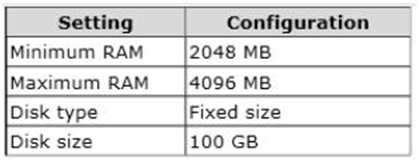
You plan to create a checkpoint of VM1.
You need to recommend a solution to minimize the amount of disk space used for the checkpoint of VM1.
What should you do before you create the checkpoint?
Correct Answer:
C
🗳️
For checkpoints created when the virtual machine is stopped
The checkpoint contains the state of the hard disks only.
For checkpoints created when the virtual machine is running
The checkpoint contains the state of the hard disks and the data in memory.
Note: A checkpoint saves the state of each virtual hard disk that is attached to a virtual machine and all of the hard disk's contents, including application data files.
For virtual machines on Hyper-V and VMware ESX Server hosts, a checkpoint also saves the hardware configuration information. By creating checkpoints for a virtual machine, you can restore the virtual machine to a previous state.
Your network contains a server named Server1 that runs Windows Server 2012. Server1 has the Hyper-V server role installed.
Server1 hosts four virtual machines named VM1, VM2, VM3, and VM4.
Server1 is configured as shown in the following table.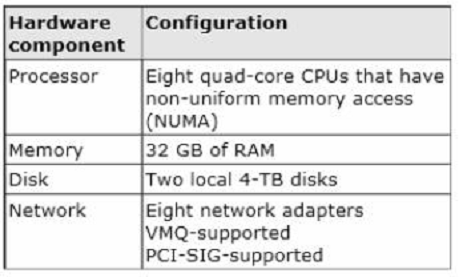
You install a network monitoring application on VM2.
You need to ensure that all of the traffic sent to VM3 can be captured on VM2.
What should you configure?
Correct Answer:
J
🗳️
http://technet.microsoft.com/en-us/library/jj679878.aspx#bkmk_portmirror
What's New in Hyper-V Virtual Switch
Port Mirroring -
With Port Mirroring, traffic sent to or from a Hyper-V Virtual Switch port is copied and sent to a mirror port.
There are a range of applications for port mirroring an entire ecosystem of network visibility companies exist that have products designed to consume port mirror data for performance management, security analysis, and network diagnostics. With Hyper-V Virtual Switch port mirroring, you can select the switch ports that are monitored as well as the switch port that receives copies of all the traffic.
The following examples configure port mirroring so that all traffic that is sent and received by both MyVM and
MyVM2 is also sent to the VM named MonitorVM.
Set-VMNetworkAdapter VMName MyVM PortMirroring Source
Set-VMNetworkAdapter VMName MyVM2 PortMirroring Source
Set-VMNetworkAdapter VMName MonitorVM PortMirroring Destination
Your network contains a server named Server1 that runs Windows Server 2012. Server1 has the Hyper-V server role installed.
Server1 hosts four virtual machines named VM1, VM2, VM3, and VM4.
Server1 is configured as shown in the following table.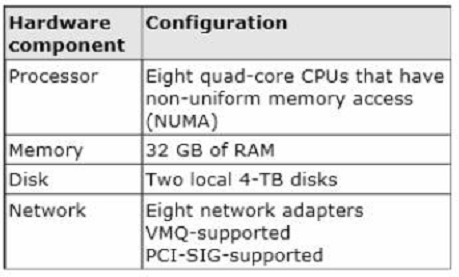
You plan to schedule a complete backup of Server1 by using Windows Server Backup.
You need to ensure that the state of VM1 is saved before the backup starts.
What should you configure?
Correct Answer:
I
🗳️
Backup Operations in Hyper-V -
No VSS Writer Available?
In some cases, you need an Application-consistent backup but there is no VSS writer available. One example of this is MySQL. Hyper-V backups of virtual machines containing MySQL will always result in either a crash consistent or an image-level backup. For MySQL, the latter is probably acceptable as MySQL doesn't perpetually expand the log file. However, if you're using MySQL within a VSS-aware VM, then a Hyper-Vbased backup tool is going to take a crash- consistent backup. MySQL (like any other database system) isn't always recoverable from a crash-consistent backup; tool is going to take a crash-consistent backup. MySQL (like any other database system) isn't always recoverable from a crash-consistent backup; even when recovery is possible, it may be painful.
MySQL is just one example; any number of line-of-business Applications could tell a similar tale. In the case of MySQL, one solution is to find a guest-level backup
Application that is MySQL- aware and can back it up properly. For Applications for which no backup Application has a plug-in, you may need to have pre- and post-backup scripts that stop services or close Applications. If brief downtime is acceptable, you can disable the Backup item in Hyper-V Integration Services, thereby forcing Hyper-V to save the state of the VM during backup. This technique results in an image-level backup and can be used on any Application that doesn't have a VSS writer.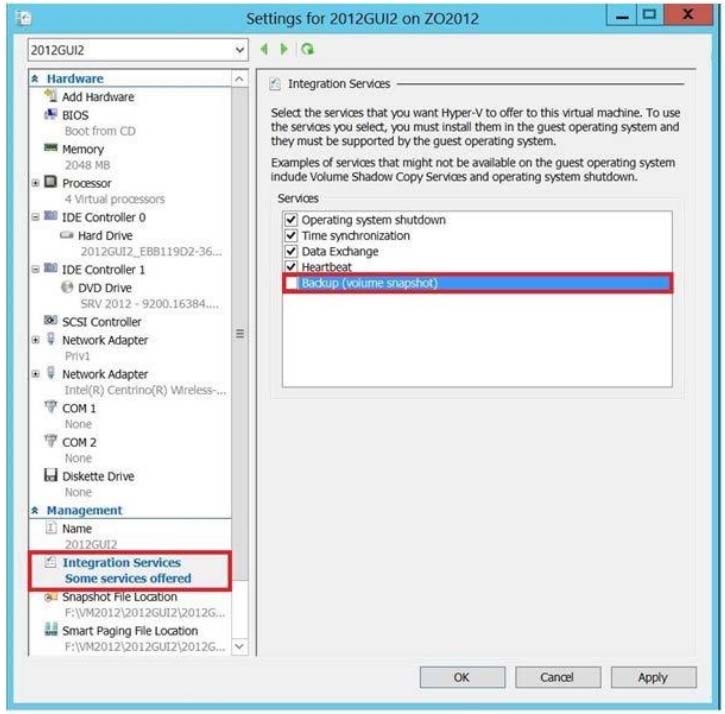
References:
https://www.altaro.com/hyper-v/vss-crash-consistent-vs-application-consistent-vss-backups-post-2-of-2/
Your network contains a server named Server1 that runs Windows Server 2012 R2. Server1 has the Hyper-V server role installed.
Server1 hosts four virtual machines named VM1, VM2, VM3, and VM4.
Server1 is configured as shown in the following table.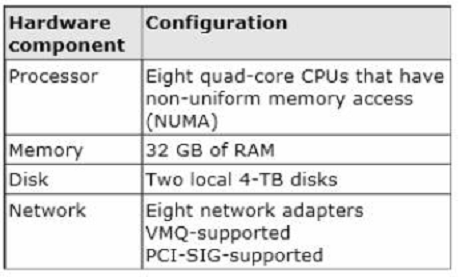
VM3 is used to test applications.
You need to prevent VM3 from synchronizing its clock to Server1.
What should you configure?
Correct Answer:
I
🗳️
Integration Services settings on virtual machines includes services such as operating system shutdown, time synchronization, data exchange, Heart beat, and
Backup (volume snapshot services. Thus you should disable the time synchronization using Integration Services.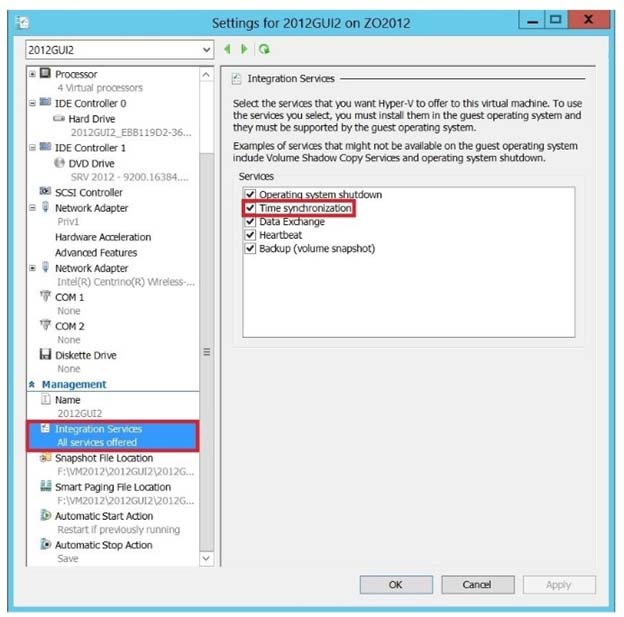
References:
http://blogs.technet.com/b/virtualization/archive/2008/08/29/backing-up-hyper-v-virtual-machines.aspx
Exam Ref 70-410, Installing and Configuring Windows Server 2012, Chapter 3: Configure Hyper-V, Objective 3.1: Create and Configure virtual machine settings, p. 144
Your network contains a server named Server1 that runs Windows Server 2012. Server1 has the Hyper-V server role installed.
Server1 hosts four virtual machines named VM1, VM2, VM3, and VM4.
Server1 is configured as shown in the following table.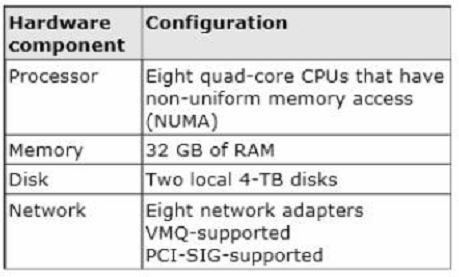
VM2 sends and receives large amounts of data over the network.
You need to ensure that the network traffic of VM2 bypasses the virtual switches of the parent partition.
What should you configure?
Correct Answer:
K
🗳️
Single-root I/O virtualization -capable network adapters can be assigned directly to a virtual machine to maximize network throughput while minimizing network latency and the CPU overhead required for processing network traffic.
References:
http://technet.microsoft.com/en-us/library/cc766320(v=ws.10).aspx http://technet.microsoft.com/en-us/library/hh831410.aspx
Exam Ref 70-410, Installing and Configuring Windows Server 2012, Chapter 3: Configure Hyper-V, Objective 3.1: Create and Configure virtual machine settings, p. 144
Training Guide: Installing and Configuring Windows Server 2012: Chapter 7: Hyper-V Virtualization, Lesson 2: Deploying and configuring virtual machines, p. 335
You perform a Server Core Installation of Windows Server 2012 R2 on a server named Server1.
You need to add a graphical user interface (GUI) to Server1.
Which tool should you use?
Correct Answer:
D
🗳️
The DISM command is called by the Add-WindowsFeature command. Here is the systax for DISM:
Dism /online /enable-feature /featurename:ServerCore-FullServer /featurename:Server- Gui-Shell /featurename:Server-Gui-Mgmt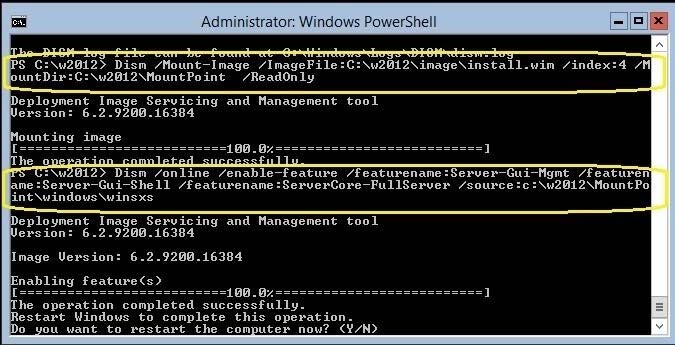
You have a server named Server1 that runs Windows Server 2012 R2.
You plan to create an image of Server1.
You need to remove the source files for all server roles that are not installed on Server1.
Which tool should you use?
Correct Answer:
A
🗳️
The Dism utility can be used to create and mount an image of Server1.
Incorrect Answers:
B: The ServerManagerCmd.exe command-line tool has been deprecated in Windows Server 2008 R2.
C: The Ocsetup.exe tool isused as a wrapper for Package Manager (Pkgmgr.exe) and for Windows Installer (Msiexec.exe). Ocsetup.exe is a command-line utility that can be used to perform scripted installs and scripted uninstalls of Windows optional components. The Ocsetup.exe tool replaces the Sysocmgr.exe tool that
Windows XP and Windows Server 2003 use.
D: ImageX is a command-line tool in Windows Vista that you can use to create and manage Windows image (.wim) files. A .wim file contains one or more volume images, disk volumes that contain images of an installed Windows operating system.
References:
http://technet.microsoft.com/en-us/library/hh824822.aspx
http://blogs.technet.com/b/joscon/archive/2010/08/26/adding-features-with- dism.aspx http://technet.microsoft.com/en-us/library/hh831809.aspx http://technet.microsoft.com/en-us/library/hh825265.aspx http://technet.microsoft.com/en-us/library/cc749447(v=ws.10).aspx http://technet.microsoft.com/en-us/library/dd744382(v=ws.10).asp
You have a server named Server1 that runs Windows Server 2012 R2. Server1 has following storage spaces:
✑ Data
✑ Users
✑ Backups
✑ Primordial
You add an additional hard disk to Server1.
You need to identify which storage space contains the new hard disk.
Which storage space contains the new disk?
Correct Answer:
A
🗳️
New Disks (Unallocated space) added to Primordial space Primordial Pool? All storage that meets acceptable criteria for Storage Spaces will be placed in the
Primordial Pool. This can be considered the default pool for devices from which any other pools will be created. Notice that there are no other virtual disks or pools at this point. The Primordial Pool will only consist of physical storage devices that do not belong to any other pools.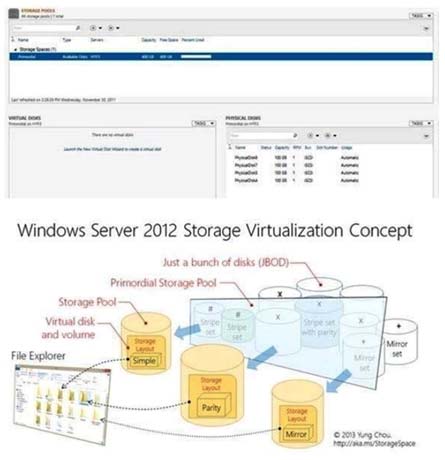
References:
http://blogs.technet.com/b/canitpro/archive/2012/12/13/storage-pools-dive-right-in.aspx http://blogs.technet.com/b/askpfeplat/archive/2012/10/10/windows-server-2012-storagespaces-is- it for-youcould-be.aspx
Your network contains an Active Directory domain named contoso.com. The domain contains a server named Server1. Server1 runs Windows Server 2012 R2.
You create a group Managed Service Account named gservice1.
You need to configure a service named Service1 to run as the gservice1 account.
How should you configure Service1?
Correct Answer:
A
🗳️
Executing the sc.exe command with the config parameter will modify service configuration. To specify a binary path for the NEWSERVICE service, type: sc config
NewService binpath= "ntsd -d c:\windows\system32\NewServ.exe"
References:
https://technet.microsoft.com/en-us/library/cc990290.aspx
http://technet.microsoft.com/en-us/library/cc738230(v=ws.10).aspx
You have a server named Data1 that runs a Server Core Installation of Windows Server 2012 R2 Standard.
You need to configure Data1 to run a Server Core Installation of Windows Server 2012 R2 Datacenter. You want to achieve this goal by using the minimum amount of administrative effort.
What should you perform?
Correct Answer:
A
🗳️
A. Not least effort -
B. Not least effort -
C. dism /online /set-edition -
D. offline would be less ideal and more work ex: DISM /online /Set-Edition:ServerEnterprise /ProductKey:489J6-VHDMP-X63PK-3K798-CPX3YWindows Server
2008 R2/2012 contains a command-line utility called DISM (Deployment Image Servicing and Management tool). This tool has many features, but one of those features is the ability to upgrade the edition of Windows in use. Note that this process is for upgrades only and is irreversible. You cannot set a Windows image to a lower edition. The lowest edition will not appear when you run the /Get-Target Editions option. If the server is running an evaluation version of Windows Server
2012 R2 Standard or Windows Server 2012 R2 Datacenter, you can convert it to a retail version as follows:
If the server is a domain controller, you cannot convert it to a retail version. In this case, install an additional domain controller on a server that runs a retail version and remove AD DS from the domain controller that runs on the evaluation version. From an elevated command prompt, determine the current edition name with the command DISM /online /Get-CurrentEdition. Make note of the edition ID, an abbreviated form of the edition name. Then run DISM /online /Set-Edition:<edition
ID> /ProductKey:XXXXXXXXXX-XXXXX-XXXXXXXXXX
/AcceptEula, providing the edition ID and a retail product key.
The server will restart twice.
There are a couple of ways to install the GUI from the command prompt, although both use the same tool -DISM (Deployment Image Service Manager).
When you are doing it for a single (local) server, the command is:
Dism /online /enable-feature /featurename:ServerCore-FullServer /featurename:...
References:
https://docs.microsoft.com/en-us/previous-versions/windows/it-pro/windows-server-2012-R2-and-2012/jj574204(v=ws.11) https://docs.microsoft.com/en-us/previous-versions/windows/it-pro/windows-7/dd744380(v=ws.10) http://blogs.technet.com/b/server_core/archive/2009/10/14/upgrading- windows-server2008-r2- without-media.aspx